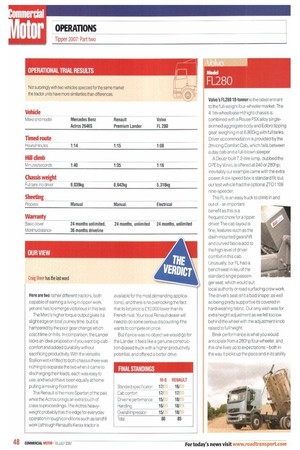FL280
Page 48

Page 49

If you've noticed an error in this article please click here to report it so we can fix it.
Volvo's F1280 18-11onner is the latest entrant to the full-weight four-wheeler market. The 4.1m-wheelbase H (high) chassis is combined with a Rouse FSX alloy singleskinned aggregate body and Ed bro tipping gear, weighing in at 6,800kg with full tanks. Driver accommodation is provided by the 2m-long Comfort Cab, which falls between a day cab and a full-blown sleeper.
A Deutz-built 7.2-litre lump, dubbed the D7E by Volvo, is offered at 240 or 280hp; inevitably our example came with the extra power. A six-speed box is standard fit, but our test vehicle had the optional ZT01109 nine-speeder.
The FL is an easy truck to climb in and out of -an important benefit as this is a frequent chore for a tipper driver. The cab layout is fine; features such as the dash-mounted gearshift and curved fascia add to the high level of driver comfort in this cab. Unusually, our FL had a bench seat in lieu of the standard single passenger seat, which would suit local authority or road surfacing crew work. The driver's seat isn't a bad shape: as well as being pretty supportive its covered in hard-wearing fabric. Our only wish was for extra height adjustment as we felt too low behind the wheel with the adjustment knob raised to full height.
Brisk performance is what you would anticipate from a 280hp four-wheeler, and this one lives up to expectations both in the way it picks up the pace and in its ability to maintain a high average speed. Not surprisingly, the fully laden FL tackled the Fossebridge climb comfortably in high range, but even more impressive was the manner in which it quickly regained the 40mph legal irnt as the slope became less severe.
When empty, the little Volvo accelerates like a go-kart, but it also bounces around like one on rough lanes, demanding a steady hand on the steering wheel to keep it on track. Put 11 tonnes of gravel in the back and the ride is much improved, while the willing engine means it still responds swiftly when the righthand pedal is depressed.
Off-road handling prompted no criticisms; it's aided by light yet accurate clutch engagement and low first and reverse gear ratios for ease of control in tight situations. Volvo's usual manual gearshifting strategy is retained; pull away in first then let the comfortably quick trigger range-change help you skip shift up through the gears for speedy progress.
The FL's cab is built in the same Blainville, France factory as the Oaf LF and Renault Midlum, but it boasts a lot of strengthening under the skin to meet the strictest Swedish crash regs, The LF and Midlum four-wheelers have occasionally left us underwhelmed in the braking department, due to a squashy feel at the middle pedal, but the Volvo's anchors proved exceptional, with accurate modulation and loads of stopping power when required.
A narrow cab is ideal for restricted sites where space is at a premium. The broad mirrors are pretty good too, despite being bulky and locking like they might be vulnerable to damage in narrow lanes. We would spec shorter mirror arms if available.
We're not sold on the FL s longer cab when it comes to productivity, particularly when matched with a non-insulated aggregates body. It not only increases vehicle length but adds at least 50kg to the truck's unladen weight. For an owner-driver or tipper fleet operator whose key concerns are manoeuvrability and payload, we would consider the regular day cab to be a better fit.
Large cab notwithstanding, the new FL is a superb (if perhaps pricey) contender in this hard-working sector.


























































































































































































